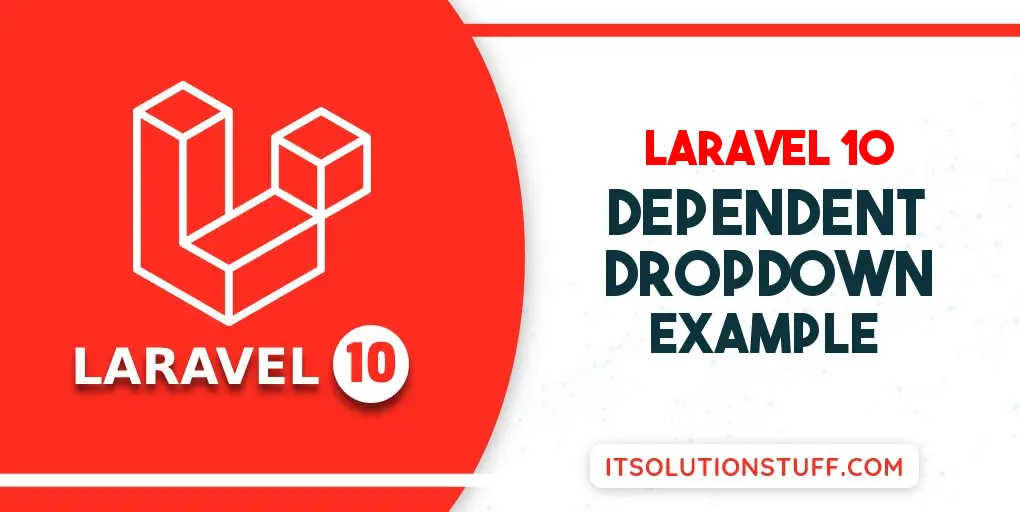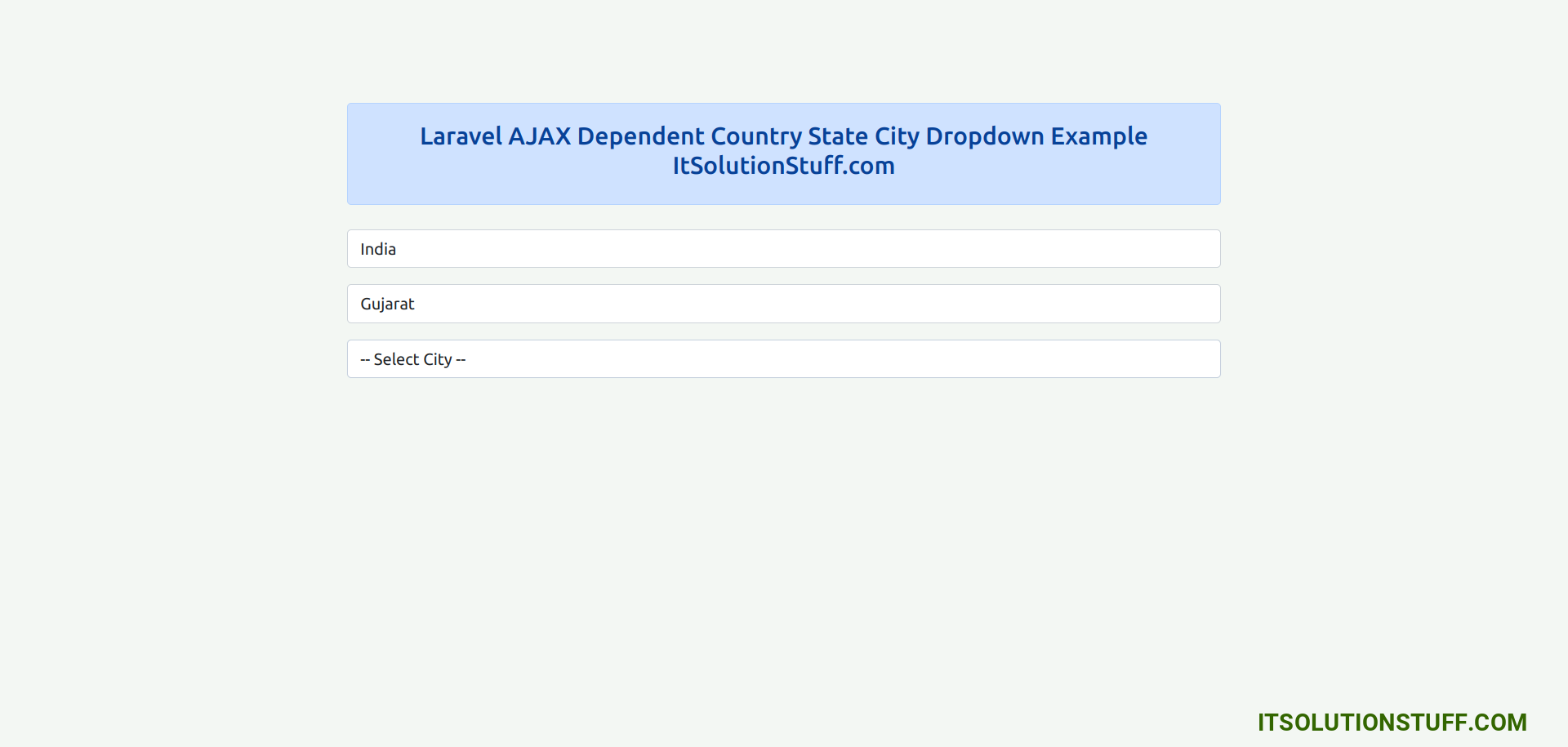Laravel 10 Dependent Dropdown Example Tutorial
Hey Friends,
Here, I will show you how to work laravel 10 dependent dropdown example. I’m going to show you about laravel 10 dynamic dependent dropdown example. I’m going to show you about laravel 10 dependent dropdown tutorial with example. Here you will learn laravel 10 country state city dropdown.
In this example, we will create a dynamic dependent dropdown for country, state, and city selection in a Laravel app. We will create a simple form with three dropdowns. When a country is selected, the corresponding states will populate in the next dropdown, and when a state is selected, the corresponding cities will populate in the third dropdown. This is a step-by-step and straightforward example, so let's follow the steps below to create it.

Step 1: Install Laravel
This step is not required; however, if you have not created the laravel app, then you may go ahead and execute the below command:
composer create-project laravel/laravel example-app
Step 2: Create Migration for Table
In this step, we will create migration for countries, states and cities table. So let's run below command to create tables.
php artisan make:migration create_countries_states_cities_tables
Next, simple update below code to migration file.
database/migrations/create_countries_states_cities_tables.php
<?php
use Illuminate\Database\Migrations\Migration;
use Illuminate\Database\Schema\Blueprint;
use Illuminate\Support\Facades\Schema;
return new class extends Migration
{
/**
* Run the migrations.
*
* @return void
*/
public function up(): void
{
Schema::create('countries', function (Blueprint $table) {
$table->id();
$table->string('name');
$table->timestamps();
});
Schema::create('states', function (Blueprint $table) {
$table->id();
$table->string('name');
$table->integer('country_id');
$table->timestamps();
});
Schema::create('cities', function (Blueprint $table) {
$table->id();
$table->string('name');
$table->integer('state_id');
$table->timestamps();
});
}
/**
* Reverse the migrations.
*
* @return void
*/
public function down(): void
{
Schema::dropIfExists('countries');
Schema::dropIfExists('states');
Schema::dropIfExists('cities');
}
};
Then run created new migration with below command:
php artisan migrate
Step 3: Create Models
In this step, we will create three models for tables Country.php, State.php and City.php model file.
so, let's run below command to create file and update following code:
php artisan make:model Country
php artisan make:model State
php artisan make:model City
You have to update your model file as below:
app/Models/Country.php
<?php
namespace App\Models;
use Illuminate\Database\Eloquent\Factories\HasFactory;
use Illuminate\Database\Eloquent\Model;
class Country extends Model
{
use HasFactory;
/**
* Write code on Method
*
* @return response()
*/
protected $fillable = [
'name'
];
}
app/Models/State.php
<?php
namespace App\Models;
use Illuminate\Database\Eloquent\Factories\HasFactory;
use Illuminate\Database\Eloquent\Model;
class State extends Model
{
use HasFactory;
/**
* Write code on Method
*
* @return response()
*/
protected $fillable = [
'name', 'country_id'
];
}
app/Models/City.php
<?php
namespace App\Models;
use Illuminate\Database\Eloquent\Factories\HasFactory;
use Illuminate\Database\Eloquent\Model;
class City extends Model
{
use HasFactory;
/**
* Write code on Method
*
* @return response()
*/
protected $fillable = [
'name', 'state_id'
];
}
Step 4: Create Route
In this step, we will add three routes with GET and POST method in routes/web.php file. so let's add it.
routes/web.php
<?php
use Illuminate\Support\Facades\Route;
use App\Http\Controllers\DropdownController;
/*
|--------------------------------------------------------------------------
| Web Routes
|--------------------------------------------------------------------------
|
| Here is where you can register web routes for your application. These
| routes are loaded by the RouteServiceProvider within a group which
| contains the "web" middleware group. Now create something great!
|
*/
Route::get('dropdown', [DropdownController::class, 'index']);
Route::post('api/fetch-states', [DropdownController::class, 'fetchState']);
Route::post('api/fetch-cities', [DropdownController::class, 'fetchCity']);
Step 5: Create Controller
In this step, we have to create new controller as DropdownController with index(), fetchState() and fetchCity() methods. so let's update follow code:
app/Http/Controllers/DropdownController.php
<?php
namespace App\Http\Controllers;
use Illuminate\Http\Request;
use App\Models\Country;
use App\Models\State;
use App\Models\City;
use Illuminate\View\View;
use Illuminate\Http\JsonResponse;
class DropdownController extends Controller
{
/**
* Write code on Method
*
* @return response()
*/
public function index(): View
{
$data['countries'] = Country::get(["name", "id"]);
return view('dropdown', $data);
}
/**
* Write code on Method
*
* @return response()
*/
public function fetchState(Request $request): JsonResponse
{
$data['states'] = State::where("country_id", $request->country_id)
->get(["name", "id"]);
return response()->json($data);
}
/**
* Write code on Method
*
* @return response()
*/
public function fetchCity(Request $request): JsonResponse
{
$data['cities'] = City::where("state_id", $request->state_id)
->get(["name", "id"]);
return response()->json($data);
}
}
Step 6: Create View File
In Last step, let's create dropdown.blade.php for display form and put following code:
resources/views/dropdown.blade.php
<!DOCTYPE html>
<html lang="{{ str_replace('_', '-', app()->getLocale()) }}">
<head>
<meta charset="utf-8">
<meta name="csrf-token" content="content">
<meta name="csrf-token" content="{{ csrf_token() }}">
<meta name="viewport" content="width=device-width, initial-scale=1">
<title>Laravel AJAX Dependent Country State City Dropdown Example - ItSolutionStuff.com</title>
<!-- CSS only -->
<link href="https://cdn.jsdelivr.net/npm/bootstrap@5.0.0-beta1/dist/css/bootstrap.min.css" rel="stylesheet">
</head>
<body>
<div class="container mt-4" >
<div class="row justify-content-center">
<div class="col-md-8">
<div class="alert alert-primary mb-4 text-center">
<h4 >Laravel AJAX Dependent Country State City Dropdown Example ItSolutionStuff.com</h4>
</div>
<form>
<div class="form-group mb-3">
<select id="country-dropdown" class="form-control">
<option value="">-- Select Country --</option>
@foreach ($countries as $data)
<option value="{{$data->id}}">
{{$data->name}}
</option>
@endforeach
</select>
</div>
<div class="form-group mb-3">
<select id="state-dropdown" class="form-control">
</select>
</div>
<div class="form-group">
<select id="city-dropdown" class="form-control">
</select>
</div>
</form>
</div>
</div>
</div>
<script src="https://ajax.googleapis.com/ajax/libs/jquery/3.5.1/jquery.min.js"></script>
<script>
$(document).ready(function () {
/*------------------------------------------
--------------------------------------------
Country Dropdown Change Event
--------------------------------------------
--------------------------------------------*/
$('#country-dropdown').on('change', function () {
var idCountry = this.value;
$("#state-dropdown").html('');
$.ajax({
url: "{{url('api/fetch-states')}}",
type: "POST",
data: {
country_id: idCountry,
_token: '{{csrf_token()}}'
},
dataType: 'json',
success: function (result) {
$('#state-dropdown').html('<option value="">-- Select State --</option>');
$.each(result.states, function (key, value) {
$("#state-dropdown").append('<option value="' + value
.id + '">' + value.name + '</option>');
});
$('#city-dropdown').html('<option value="">-- Select City --</option>');
}
});
});
/*------------------------------------------
--------------------------------------------
State Dropdown Change Event
--------------------------------------------
--------------------------------------------*/
$('#state-dropdown').on('change', function () {
var idState = this.value;
$("#city-dropdown").html('');
$.ajax({
url: "{{url('api/fetch-cities')}}",
type: "POST",
data: {
state_id: idState,
_token: '{{csrf_token()}}'
},
dataType: 'json',
success: function (res) {
$('#city-dropdown').html('<option value="">-- Select City --</option>');
$.each(res.cities, function (key, value) {
$("#city-dropdown").append('<option value="' + value
.id + '">' + value.name + '</option>');
});
}
});
});
});
</script>
</body>
</html>
Step 7: Create Seeder
In this step, we will create "CountrySateCitySeeder" file to create dummy records. so let's create seeder and run it.
Create Seeder file using below command:
php artisan make:seeder CountrySateCitySeeder
let's update following code on seeder file:
database/seeders/CountrySateCitySeeder.php
<?php
namespace Database\Seeders;
use Illuminate\Database\Console\Seeds\WithoutModelEvents;
use Illuminate\Database\Seeder;
use App\Models\Country;
use App\Models\State;
use App\Models\City;
class CountrySateCitySeeder extends Seeder
{
/**
* Run the database seeds.
*
* @return void
*/
public function run(): void
{
/*------------------------------------------
--------------------------------------------
US Country Data
--------------------------------------------
--------------------------------------------*/
$country = Country::create(['name' => 'United State']);
$state = State::create(['country_id' => $country->id, 'name' => 'Florida']);
City::create(['state_id' => $state->id, 'name' => 'Miami']);
City::create(['state_id' => $state->id, 'name' => 'Tampa']);
/*------------------------------------------
--------------------------------------------
India Country Data
--------------------------------------------
--------------------------------------------*/
$country = Country::create(['name' => 'India']);
$state = State::create(['country_id' => $country->id, 'name' => 'Gujarat']);
City::create(['state_id' => $state->id, 'name' => 'Rajkot']);
City::create(['state_id' => $state->id, 'name' => 'Surat']);
}
}
Next, run seeder with below command:
php artisan db:seed --class=CountrySateCitySeeder
Run Laravel App:
All the required steps have been done, now you have to type the given below command and hit enter to run the Laravel app:
php artisan serve
Now, Go to your web browser, type the given URL and view the app output:
http://localhost:8000/dropdown
Output:

I hope it can help you...

